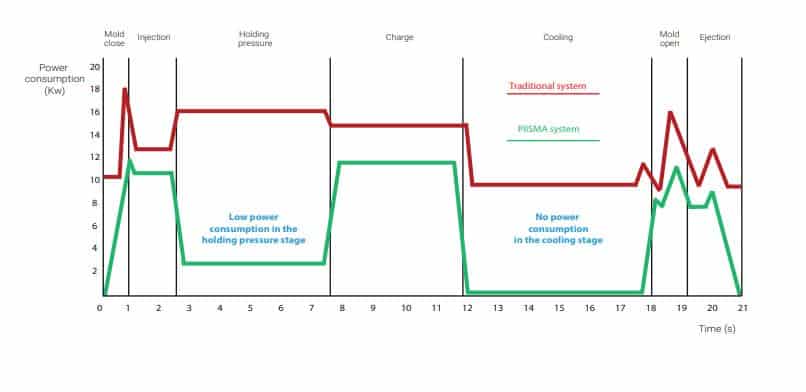Nowadays technology can offer solutions that can provide an energy saving up to 80% by means of systems that exploit intelligently machine downtimes. Let's find out the benefits of servopump systems.
With a certain sense of resignation, we are used to thinking that the production of heat and energy and the increase in noise are inevitable factors when hydraulic presses are in operation. This happens because hydraulic systems are often oversized, and supply more energy than necessary. This consequently also leads to excessive noise linked to the rotation speed of the pump and operating pressure.
There are now solutions that can offer energy savings of up to 80%, simply thanks to a system that allows the intelligent exploitation of machine downtime.
 This technology is still little known, but has great potential of growth in the press sector and can significantly contribute to improving the quality of work of the operators, thanks to the reduction of up to 20 dB of noise during machine operation and 100% during downtime. This applies both to newly built plants and for those that require revision or the modernisation of existing presses with revamping interventions.
This technology is still little known, but has great potential of growth in the press sector and can significantly contribute to improving the quality of work of the operators, thanks to the reduction of up to 20 dB of noise during machine operation and 100% during downtime. This applies both to newly built plants and for those that require revision or the modernisation of existing presses with revamping interventions.
In a typical work cycle of a hydraulic press, most of the energy is needed to generate the force necessary to perform the main task of pressing or injection.
Traditional systems use a variable displacement pump driven by a motor with a constant number of revolutions, which always remains in operation even when the machine is inactive, such as during loading operations.
This results in a waste of energy, which is added to that necessary to start the oil cooling system every time it overheats and restore it to optimal conditions of use.
The servopump technology
The novelty of this kind of innovative system lies in the significant improvement in the efficiency of presses, thanks to an inverter-controlled variable speed servomotor coupled with a constant flow internal gear pump, whose power can be adapted to actual requirements in such a way as to almost completely eliminate losses when the machine is inactive.
The pump motor also stops when the machine is not in movement, unlike that of traditional hydraulic presses, in which the pump continues to circulate oil even while the machine is inactive.
By regulating the number of revolutions and pressure, it is possible to have different ranges of pressure and flow rates according to the needs of the cycle. The flow rate of the hydraulic pump is proportional to the speed of the electric motor.
The energy consumption of injection moulding machines with the servo pump system can thus be more than halved, with a consequent increase in production efficiency.
For machine overhauls and the modernisation of existing presses, the use of the servo pump system can significantly improve system use while significantly reducing energy costs and noise levels. The modular system with a servo pump can be installed on any existing press, both small and large tonnage, with a circuit equipped with a traditional pump and an oil-pneumatic accumulator circuit.
It is important to note that the operation of the machine is not modified, because the functional performance in terms of default speed and/or pressure remain unchanged thanks to the possibility of calibrating the system upon installation.





